|
|
|
Sort Order |
|
|
|
Items / Page
|
|
|
|
|
|
|
| Srl | Item |
| 1 |
ID:
171891
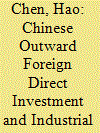

|
|
|
|
|
| Summary/Abstract |
This paper constructs a two‐sector model to identify the effects of outward foreign direct investment (OFDI) in different countries on China's industrial upgrading and conducts an empirical analysis using provincial‐level panel data from 2003–2015. The results show that China can benefit from industrial upgrading via OFDI in developed countries by way of reverse technology spillover. This effect is significant in the eastern region, but not in the central and western regions. China can also benefit from industrial upgrading via OFDI in developing countries and countries along the Belt and Road through marginal industrial transfer. This effect is more significant in the central region, followed by the western and eastern regions. Our results imply that China should promote technology‐seeking OFDI in developed countries, and enhance efficiency‐seeking OFDI in developing countries, especially in countries along the Belt and Road.
|
|
|
|
|
|
|
|
|
|
|
|
|
|
|
|
| 2 |
ID:
180111
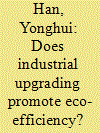

|
|
|
|
|
| Summary/Abstract |
Industrial upgrading plays a significant role in promoting eco-efficiency, but existing studies ignore this aspect. Using improved and comprehensive measures of eco-efficiency, we assess how industrial upgrading influences the eco-efficiency of a certain province with provincial panel data during the period 1998–2017. We find that industrial upgrading significantly promotes eco-efficiency and yields significantly positive spatial spillover effects. Our findings provide empirical evidence that the government should push forward industrial upgrading decisively, as well as strengthening inter-regional and central-provincial collaboration in promoting eco-efficiency.
|
|
|
|
|
|
|
|
|
|
|
|
|
|
|
|
| 3 |
ID:
144041
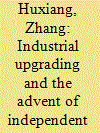

|
|
|
|
|
| Summary/Abstract |
In recent years, the development mode of China’s animation industry changed from “offshoring” to “innovation”. China’s domestic animation has since achieved rapid advancement in the creation of original characters, animation production and sales, development of cartoon-related products, cultivation of the animation market and industrial upgrading. This article investigates the upgrading progress of China’s animation industry. To transform the country’s economic growth model and strengthen ideological control, the Chinese government promoted culture industrialisation, including animation. There has been a shift in the function of animation from edutainment to a balanced mix of edutainment and commercial success. On the one hand, the Chinese government regards animation as an important part of the knowledge-intensive cultural and creative industries, and lends its support for a breakthrough in transforming the economic growth model. On the other hand, the government insists on domestic animation to fulfil its indoctrination function to promote mainstream culture, as well as on implementing a slew of policies to reinforce domestic culture dominance in the society such as the “differentiated” broadcasting policy, incentive policy on production, flexible review and management policy, and market development and regulatory policy aimed at building the industrial chain. All of these policies form the substance of the transformation and upgrading of China’s domestic animation industry.
|
|
|
|
|
|
|
|
|
|
|
|
|
|
|
|
| 4 |
ID:
130585
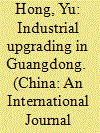

|
|
|
|
|
| Publication |
2014.
|
| Summary/Abstract |
Guangdong has played an important role and been in the vanguard of China's economic reforms and opening up since 1978. Industrial production in Guangdong has expanded rapidly, which in turn led to rapid growth in the economy. Fast industrialisation followed and Guangdong has since developed to become the industrial powerhouse for China and the world. Nevertheless, over the recent years, Guangdong has been facing both internal and external pressures to increase its industrial competitiveness and undertake industrial upgrading. Industrial upgrading has been the focal point of government policies since the early 2000s. However, the results from industrial upgrading are not too encouraging and problematic industrial policies have thwarted the government's aspirations for industrial upgrading rather than speeding up the process. In addition, Guangdong's aspirations to move up the value chain and achieve industrial upgrading are met with various obstacles and challenges. Guangdong's industrial development is still mainly driven by the low-end and low value-added manufacturing industry, and the status quo of Guangdong as the world's low-end assembly and processing base remains unchanged.
|
|
|
|
|
|
|
|
|
|
|
|
|
|
|
|
| 5 |
ID:
156082
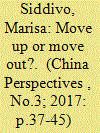

|
|
|
|
|
| Summary/Abstract |
China is equipping itself with a mid-long-term strategy to sustain its manufacturing sector in the face of potential challenges brought about by “disruptive” technologies. According to most analysts, disruptive technologies such as 3D printing, the Internet of things (IoT), big data, and robotics are going to modify the “shop floor” and re-allocate the functions and roles of firms empowered in the global value chains (GVCs). In China, scholars, state officials, and the entrepreneurial community have profoundly analysed the impact that disruptive technologies can exert on their firms’ role in the global value chains, reaching the conclusion that the country has to frame a policy to hedge that risk. This paper aims to provide an overview of the debate stirred up by the confrontation of the national manufacturing sector with the introduction of new technologies. The debate, which has involved many institutional and economic actors, has influenced the industrial plans recently drawn up by the Ministry of Industry and Information Technology (MIIT).
|
|
|
|
|
|
|
|
|
|
|
|
|
|
|
|
| 6 |
ID:
127635
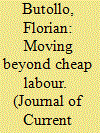

|
|
|
|
|
| Publication |
2013.
|
| Summary/Abstract |
Based on field studies in the Pearl River Delta (PRD) in 2010 and 2011, specific paths of industrial upgrading in the garment and IT industries are identified. The analysis reveals that there exists a multiplicity of upgrading trajectories, all of which have different implications for skill development and the character of work. While the modernization of industries relies on the input of higher skilled work, primarily in the fields of R&D and marketing, this barely is the case with regard to manufacturing. While labour intensity in the examined cases is diminishing in absolute or relative terms, internal divisions between low-skilled and high-skilled work are reconfigured rather than overcome.
|
|
|
|
|
|
|
|
|
|
|
|
|
|
|
|
| 7 |
ID:
144042
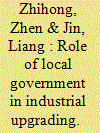

|
|
|
|
|
| Summary/Abstract |
This article examines China’s largest textile industrial cluster in Shaoxing county as a case study of how developing countries could carry out industrial upgrading in the face of globalisation’s challenges. The authors argue that the local government could play a crucial role in transforming comparative advantages of the local economy into competitive advantages using various policy tools. The Shaoxing county government rewarded and subsidised local textile enterprises to carry out independent innovation and research and development (R&D), facilitated foreign investments and technology transfer, guided local enterprises to build up their own brands, introduced preferential policies to encourage local enterprises to participate in international competition and motivated local enterprises to expand export. This demonstrates that the county government’s guiding hand and policy measures are instrumental in leading textile enterprises to reshape their competitive advantage, integrate into the global market and upgrade the industry.
|
|
|
|
|
|
|
|
|
|
|
|
|
|
|
|
|
|
|
|
|